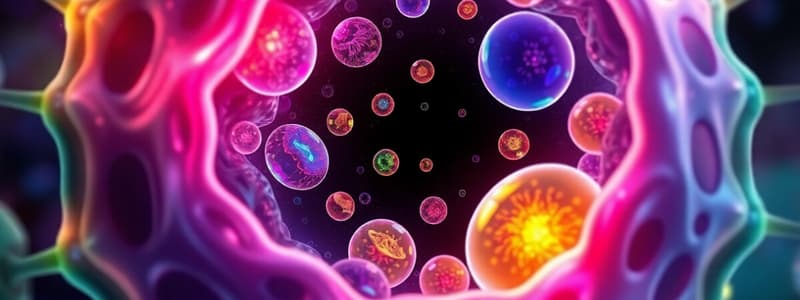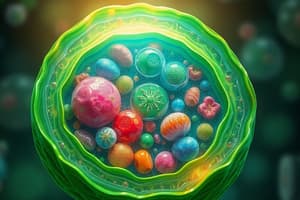Podcast
Questions and Answers
What is the main function of chloroplasts in plant cells?
What is the main function of chloroplasts in plant cells?
- To convert solar energy into chemical energy (correct)
- To store water and nutrients
- To break down waste materials
- To transport materials across the cell membrane
Which of the following structures is present in plant cells but absent in animal cells?
Which of the following structures is present in plant cells but absent in animal cells?
- Mitochondria
- Ribosomes
- Lysosomes
- Cell wall (correct)
What role do mitochondria play in cells?
What role do mitochondria play in cells?
- Facilitating photosynthesis
- Synthesizing proteins
- Storing genetic material
- Producing energy through respiration (correct)
Which of the following is a characteristic feature of prokaryotic organisms?
Which of the following is a characteristic feature of prokaryotic organisms?
Which organelle is primarily responsible for digestion within the cell?
Which organelle is primarily responsible for digestion within the cell?
What is the correct order of biological organization starting from the simplest?
What is the correct order of biological organization starting from the simplest?
What is the primary role of the plasma membrane in a cell?
What is the primary role of the plasma membrane in a cell?
Which organism type is characterized by having membrane-bound organelles?
Which organism type is characterized by having membrane-bound organelles?
What type of cells contain chlorophyll?
What type of cells contain chlorophyll?
What type of metabolic processes do mitochondria and chloroplasts share?
What type of metabolic processes do mitochondria and chloroplasts share?
What is the primary function of lysosomes in a cell?
What is the primary function of lysosomes in a cell?
Which component of the cell membrane allows for the selective passage of substances?
Which component of the cell membrane allows for the selective passage of substances?
What is the main role of the cell wall in plant cells?
What is the main role of the cell wall in plant cells?
What distinguishes the function of ribosomes within a cell?
What distinguishes the function of ribosomes within a cell?
What is the role of vacuoles in plant cells?
What is the role of vacuoles in plant cells?
How do plastids primarily support cellular processes in plant cells?
How do plastids primarily support cellular processes in plant cells?
Which part of the nucleus contains nucleic acids?
Which part of the nucleus contains nucleic acids?
How are molecules primarily transported across the cell membrane?
How are molecules primarily transported across the cell membrane?
What distinguishes the cytoplasm from other cell components?
What distinguishes the cytoplasm from other cell components?
Which of the following options correctly describes the endoplasmic reticulum?
Which of the following options correctly describes the endoplasmic reticulum?
Which component found in the nucleus is essential for protein synthesis?
Which component found in the nucleus is essential for protein synthesis?
Which of the following statements about unicellular organisms is true?
Which of the following statements about unicellular organisms is true?
What is the main role of hydrolytic enzymes found in lysosomes?
What is the main role of hydrolytic enzymes found in lysosomes?
Which statement best describes the structure of the cell wall in plant cells?
Which statement best describes the structure of the cell wall in plant cells?
What distinguishes mitochondria from other organelles in eukaryotic cells?
What distinguishes mitochondria from other organelles in eukaryotic cells?
Which is a key function of chloroplasts in plant cells?
Which is a key function of chloroplasts in plant cells?
What type of structures exist in prokaryotic cells?
What type of structures exist in prokaryotic cells?
What characteristic of vacuoles is notable in plant cells?
What characteristic of vacuoles is notable in plant cells?
What is a primary cellular function of the Golgi apparatus?
What is a primary cellular function of the Golgi apparatus?
How do unicellular eukaryotic organisms differ from prokaryotic organisms?
How do unicellular eukaryotic organisms differ from prokaryotic organisms?
Which statement accurately explains the primary role of the plasma membrane?
Which statement accurately explains the primary role of the plasma membrane?
What essential role do ribosomes play in the cell?
What essential role do ribosomes play in the cell?
What distinguishes the composition of the cell membrane from that of the cell wall?
What distinguishes the composition of the cell membrane from that of the cell wall?
In what way do vacuoles contribute to plant cell functions?
In what way do vacuoles contribute to plant cell functions?
What are lysosomes often referred to due to their role in cell digestion?
What are lysosomes often referred to due to their role in cell digestion?
Which statement accurately describes the process of diffusion in a cell?
Which statement accurately describes the process of diffusion in a cell?
What is the primary function of the endoplasmic reticulum in a cell?
What is the primary function of the endoplasmic reticulum in a cell?
What is the main function of nucleoli within the nucleus?
What is the main function of nucleoli within the nucleus?
Which component of the cell is primarily responsible for facilitating the movement of substances in and out of the cell?
Which component of the cell is primarily responsible for facilitating the movement of substances in and out of the cell?
What characterizes the function of plastids in plant cells?
What characterizes the function of plastids in plant cells?
Which statement accurately describes the nature of cytoplasm in a cell?
Which statement accurately describes the nature of cytoplasm in a cell?
Flashcards are hidden until you start studying
Study Notes
Cell Fundamentals
- A cell is the basic unit of life, essential for all organisms.
- Cells can be either living or non-living functional units.
Organelles in Plant Cells
- Chloroplasts, found in plant cells, produce food via photosynthesis using chlorophyll.
- Mitochondria and chloroplasts are vital for energy production and converting energy into glucose.
Cell Structure
- The plasma membrane is a flexible, protective layer surrounding the cell, allowing substance exchange.
- The cell wall, rigid and protective, provides structural support to plant cells.
Cell Functions and Components
- Lysosomes contain hydrolytic enzymes aiding in the digestion of biomolecules, termed the "clean-up" organelles.
- Key organelles include: nucleus (genetic material), cytoplasm (fluid matrix), endoplasmic reticulum (protein and lipid synthesis), plastids (photosynthesis), golgi apparatus (modification and packaging), and vacuoles (storage).
Multicellular Organization
- Cells group to form tissues, which aggregate to create organs, culminating in organ systems that function together in organisms.
Unicellular Organisms
- Two main categories: prokaryotes (simple cells, e.g., bacteria) and eukaryotes (complex cells with organelles).
- Unicellular organisms are microscopic, metabolically diverse, and can be seen only under a microscope.
Characteristics of Cells
- Plasma membrane controls material movement.
- Cell wall provides external protection.
- Nucleus houses genetic information essential for cell function.
- Mitochondria are responsible for respiration and energy production.
- Plastids engage in photosynthesis and storage.
Energy Molecules
- Adenosine triphosphate (ATP) is a key molecule for energy transfer within cells.
Cellular Components
- The cytoplasm is a mixture of water, salts, and proteins functioning in cellular processes.
- Organelles perform specific functions, ensuring cell viability and replication.
Vacuoles and Ribosomes
- Vacuoles serve as storage sacs for food, water, and waste, providing turgidity to plant cells.
- Ribosomes are small, spherical structures for protein synthesis, found in cytoplasm or attached to the endoplasmic reticulum.
Additional Insights
- The cell membrane is selectively permeable and fragile, while the cell wall is thick, non-living, and made of cellulose, hemicellulose, and pectin.
- Nucleolus contains RNA and proteins and is involved in ribosome production.
- Diffusion and osmosis facilitate the movement of CO2 and water into cells, respectively.
Online Learning Resource
- Ziyyara provides global online tuition for grades 1 to 12 and language classes in various languages, fostering educational growth.
Cell Fundamentals
- A cell is the basic unit of life, essential for all organisms.
- Cells can be either living or non-living functional units.
Organelles in Plant Cells
- Chloroplasts, found in plant cells, produce food via photosynthesis using chlorophyll.
- Mitochondria and chloroplasts are vital for energy production and converting energy into glucose.
Cell Structure
- The plasma membrane is a flexible, protective layer surrounding the cell, allowing substance exchange.
- The cell wall, rigid and protective, provides structural support to plant cells.
Cell Functions and Components
- Lysosomes contain hydrolytic enzymes aiding in the digestion of biomolecules, termed the "clean-up" organelles.
- Key organelles include: nucleus (genetic material), cytoplasm (fluid matrix), endoplasmic reticulum (protein and lipid synthesis), plastids (photosynthesis), golgi apparatus (modification and packaging), and vacuoles (storage).
Multicellular Organization
- Cells group to form tissues, which aggregate to create organs, culminating in organ systems that function together in organisms.
Unicellular Organisms
- Two main categories: prokaryotes (simple cells, e.g., bacteria) and eukaryotes (complex cells with organelles).
- Unicellular organisms are microscopic, metabolically diverse, and can be seen only under a microscope.
Characteristics of Cells
- Plasma membrane controls material movement.
- Cell wall provides external protection.
- Nucleus houses genetic information essential for cell function.
- Mitochondria are responsible for respiration and energy production.
- Plastids engage in photosynthesis and storage.
Energy Molecules
- Adenosine triphosphate (ATP) is a key molecule for energy transfer within cells.
Cellular Components
- The cytoplasm is a mixture of water, salts, and proteins functioning in cellular processes.
- Organelles perform specific functions, ensuring cell viability and replication.
Vacuoles and Ribosomes
- Vacuoles serve as storage sacs for food, water, and waste, providing turgidity to plant cells.
- Ribosomes are small, spherical structures for protein synthesis, found in cytoplasm or attached to the endoplasmic reticulum.
Additional Insights
- The cell membrane is selectively permeable and fragile, while the cell wall is thick, non-living, and made of cellulose, hemicellulose, and pectin.
- Nucleolus contains RNA and proteins and is involved in ribosome production.
- Diffusion and osmosis facilitate the movement of CO2 and water into cells, respectively.
Online Learning Resource
- Ziyyara provides global online tuition for grades 1 to 12 and language classes in various languages, fostering educational growth.
Studying That Suits You
Use AI to generate personalized quizzes and flashcards to suit your learning preferences.




